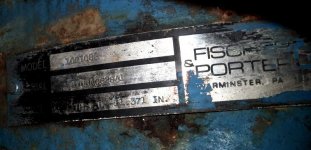OkiePC
Lifetime Supporting Member
My experience with this type of flowmeter is limited.
I am not sure if this is a venturi or some other type.
It has a data plate and we have a call in to ABB who bought the old company who made it to try to get information about it.
The DP transmitter has failed. It is not the original transmitter, but a cheap replacement installed many years ago. The plant operator has ordered an identical replacement as a first step.
I wanted to verify the logic in the PLC that is used to convert the DP to flow rate, but I inherited the logic without comments so I am not certain it was done right, not sure if the logic matches the transmitter. The only other two times I have worked on this type of transmitter, in both cases the PLC logic was not even close to correct.
The pipe is supposed to be 20" diameter. The fluid is gravity fed water from a storage tank about 55' of head. This is a backwash flow line for a rapid gravity filter.
The 2nd picture shows the ports used by the DP transmitter at the bottom right in the frame. The port on top appears to be routed to an old pressure sensor that has been abandoned.
Can someone help me identify first the type of meter this is and guide me to some links to the math? I will post snippets of the PLC logic later.
Thanks!
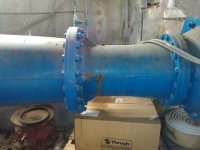
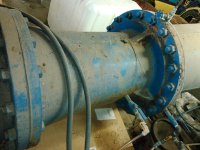
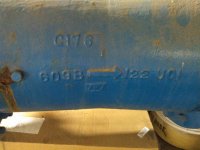
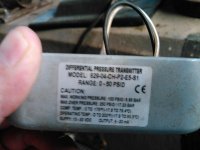
I am not sure if this is a venturi or some other type.
It has a data plate and we have a call in to ABB who bought the old company who made it to try to get information about it.
The DP transmitter has failed. It is not the original transmitter, but a cheap replacement installed many years ago. The plant operator has ordered an identical replacement as a first step.
I wanted to verify the logic in the PLC that is used to convert the DP to flow rate, but I inherited the logic without comments so I am not certain it was done right, not sure if the logic matches the transmitter. The only other two times I have worked on this type of transmitter, in both cases the PLC logic was not even close to correct.
The pipe is supposed to be 20" diameter. The fluid is gravity fed water from a storage tank about 55' of head. This is a backwash flow line for a rapid gravity filter.
The 2nd picture shows the ports used by the DP transmitter at the bottom right in the frame. The port on top appears to be routed to an old pressure sensor that has been abandoned.
Can someone help me identify first the type of meter this is and guide me to some links to the math? I will post snippets of the PLC logic later.
Thanks!




Last edited:







